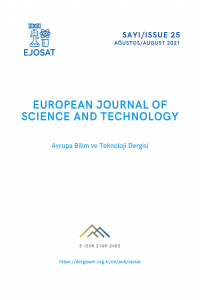The Effect of Graphite/Pure Water Nanofluid Usage on Thermal Performance in Plate Type Heat Exchanger
Öz
Increasing the heat transfer and minimizing the pressure drop value is important in terms of development the thermal performance of heat exchangers, and it is a subject that a large number of studies conducted. To increase the heat transfer rate increase the heat transfer rate, nanofluids with superior thermophysical properties are used in heat exchangers. In this study, the effect of graphite-water nanofluid use on heat transfer, efficiency coefficient and improvement rate in the plate heat exchanger in the combined hot water preparation system was investigated experimentally. In the study, cold water flows were taken as 4, 5, 6, 7 l/min and hot fluid inlet temperatures as 40, 45, 50, 55, 60˚C. According to the results, while the highest improvement rate was achieved at a rate of 0.25% nanofluid by volume, 10% at a volumetric flow rate of 4 l/min, it was determined that the heat transfer increased and the recovery rate decreased as the flow rate increased.
Anahtar Kelimeler
Nanofluid Plate heat exchanger Graphite Pure water Effectiveness
Proje Numarası
FYL-2020-2253
Kaynakça
- Bhattad, A., Sarkar, J., Ghosh, P. (2018). Discrete phase numerical model and experimental study of hybrid nanofluid heat transfer and pressure drop in plate heat exchanger. International Communications in Heat and Mass Transfer, 91, 262-273.
- Chun B.H., Kang H.U., Kim S.H. (2008). Effect of alumina nanoparticles in the fluid on heat transfer in double-pipe heat exchanger system. Korean Journal of Chemical Engineering, 25(5), 966-971.
- Huang, D., Wu, Z. (2016). Sunden B, Effects of hybrid nanofluid mixture in plate heat exchangers. Experimental Thermal and Fluid Science, 72, 190-196.
- Maxwell, J.C., Garnett, J.C. (1904). Colours in metal glasses and in metallic films. Philosophical Transactions of the Royal Society a Mathematical, Physical and Engeneering Sciences, 203, 385–420.
- Pak, B.C., Choi, Y.I. (1998). Hydrodynamic and heat transfer study of dispersed fluids with submicron metallic oxide particle. Experimental Heat Transfer and International Journal, 11 (2), 151–170.
- Sarafraz, M.M., Hormozi, F. (2016). Heat transfer pressure drop and fouling studies of multi-walled carbon nanotube nano-fluids inside a plate heat exchanger. Experimental Thermal and Fluid Science, 72, 1-11.
- Selbaş, R., Sencan, A.M., Kılıç, B. (2009). Alternative approach in thermal analysis of plate heat exchanger. Heat and Mass Transfer, 45, 323‐329.
- Variyenli, H.İ., Sarı, Y.,(2016). Magnezyum oksit ile saf suyun plaka tip ısı değiştiricideki ısıl performanslarının deneysel incelenmesi. Gazi Mühendislik Bilimleri Dergisi, 2(3), 147‐170.
- Xuan, Y., Roetzel, W. (2000). Conceptions for heat transfer correlation of nanofluids. International Journal of Heat and Mass Transfer, 43(19), 3701–3707.
- Zamzamian, A., Oskouie, S.N., Doosthoseini, A., Joneidi, A., Pazouki, M. (2011). Experimental investigation of forced convective heat transfer coefficient in nanofluids of Al2O3/EG and Cuo/EG in a double pipe and plate heat exchangers under turbulent flow. Experimental Thermal and Fluid Science, 35, 495–502.
Öz
Isı transferini artırmak ve basınç düşüş değerini en aza indirmek, ısı değiştirgeçlerinin ısıl performansını iyileştirmek açısından önemli olup üzerinde çok sayıda çalışma yapılan bir konudur. Isı transfer oranını artırmak için, üstün termofiziksel özellikli nanoakışkanlar ısı değiştiricilerinde kullanılmaktadırlar. Bu çalışmada birleşik sıcak su hazırlama sisteminde bulunan plakalı ısı değiştiricisinde grafit-su nanoakışkanı kullanımının ısı transferine, etkinlik katsayısına ve iyileştirme oranına etkisi deneysel olarak incelenmiştir. Çalışmada soğuk su debileri 4, 5, 6, 7 l/dk, sıcak akışkan giriş sıcaklıkları ise 40, 45, 50, 55, 60˚C olarak alınmıştır. Elde edilen sonuçlara göre hacimce %0.25 nanoakışkan oranında en yüksek iyileştirme oranı 4 l/dk debi değerinde %10 olarak elde edilirken, debi arttıkça ısı transferinin arttığı ve iyileşme oranının düştüğü belirlenmiştir
Anahtar Kelimeler
Nanoakışkan Plakalı ısı değiştiricisi Grafit Saf su Etkinlik
Destekleyen Kurum
İnönü Üniversitesi Bilimsel Araştırma Projeleri Birimi
Proje Numarası
FYL-2020-2253
Teşekkür
Bu çalışmayı (FYL-2020-2253) proje kodu ile destekleyen İnönü Üniversitesi Bilimsel Araştırma Projeleri Birimine teşekkür ederiz. Ayrıca nanoakışkan İnönü üniversitesi Gıda Mühendisliği Laboratuvarında hazırlanmış olup, bu konuda yardımcı olan Prof. Dr. Ali Adnan Hayaloğlu’na teşekkür ederiz
Kaynakça
- Bhattad, A., Sarkar, J., Ghosh, P. (2018). Discrete phase numerical model and experimental study of hybrid nanofluid heat transfer and pressure drop in plate heat exchanger. International Communications in Heat and Mass Transfer, 91, 262-273.
- Chun B.H., Kang H.U., Kim S.H. (2008). Effect of alumina nanoparticles in the fluid on heat transfer in double-pipe heat exchanger system. Korean Journal of Chemical Engineering, 25(5), 966-971.
- Huang, D., Wu, Z. (2016). Sunden B, Effects of hybrid nanofluid mixture in plate heat exchangers. Experimental Thermal and Fluid Science, 72, 190-196.
- Maxwell, J.C., Garnett, J.C. (1904). Colours in metal glasses and in metallic films. Philosophical Transactions of the Royal Society a Mathematical, Physical and Engeneering Sciences, 203, 385–420.
- Pak, B.C., Choi, Y.I. (1998). Hydrodynamic and heat transfer study of dispersed fluids with submicron metallic oxide particle. Experimental Heat Transfer and International Journal, 11 (2), 151–170.
- Sarafraz, M.M., Hormozi, F. (2016). Heat transfer pressure drop and fouling studies of multi-walled carbon nanotube nano-fluids inside a plate heat exchanger. Experimental Thermal and Fluid Science, 72, 1-11.
- Selbaş, R., Sencan, A.M., Kılıç, B. (2009). Alternative approach in thermal analysis of plate heat exchanger. Heat and Mass Transfer, 45, 323‐329.
- Variyenli, H.İ., Sarı, Y.,(2016). Magnezyum oksit ile saf suyun plaka tip ısı değiştiricideki ısıl performanslarının deneysel incelenmesi. Gazi Mühendislik Bilimleri Dergisi, 2(3), 147‐170.
- Xuan, Y., Roetzel, W. (2000). Conceptions for heat transfer correlation of nanofluids. International Journal of Heat and Mass Transfer, 43(19), 3701–3707.
- Zamzamian, A., Oskouie, S.N., Doosthoseini, A., Joneidi, A., Pazouki, M. (2011). Experimental investigation of forced convective heat transfer coefficient in nanofluids of Al2O3/EG and Cuo/EG in a double pipe and plate heat exchangers under turbulent flow. Experimental Thermal and Fluid Science, 35, 495–502.
Ayrıntılar
| Birincil Dil | Türkçe |
|---|---|
| Konular | Mühendislik |
| Bölüm | Makaleler |
| Yazarlar | |
| Proje Numarası | FYL-2020-2253 |
| Yayımlanma Tarihi | 31 Ağustos 2021 |
| Yayımlandığı Sayı | Yıl 2021 Sayı: 25 |

